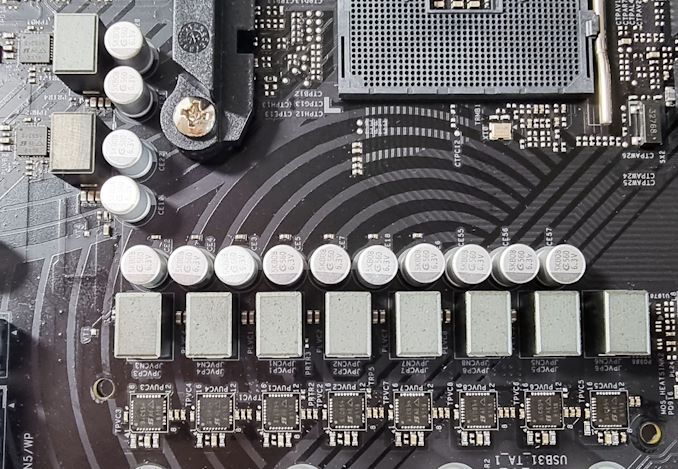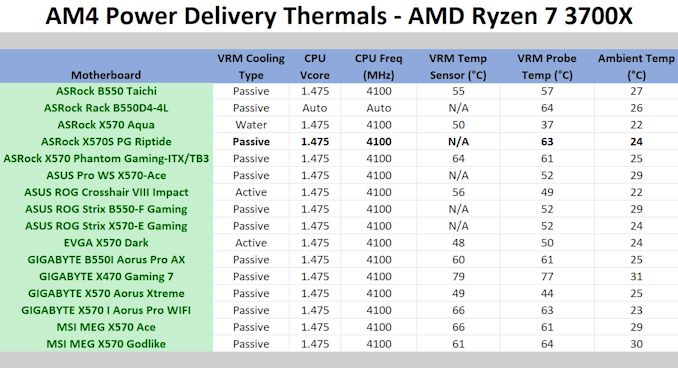The ASRock X570S PG Riptide Motherboard Review: A Wave of PCIe 4.0 Support on A Budget
by Gavin Bonshor on October 22, 2021 9:00 AM ESTPower Delivery Thermal Analysis
One of the most requested elements of our motherboard reviews revolves around the power delivery and its componentry. Aside from the quality of the components and its capability for overclocking to push out higher clock speeds which in turn improves performance, is the thermal capability of the cooling solutions implemented by manufacturers. While almost always fine for users running processors at default settings, the cooling capability of the VRMs isn't something that users should worry too much about, but for those looking to squeeze out extra performance from the CPU via overclocking, this puts extra pressure on the power delivery and in turn, generates extra heat. This is why more premium models often include heatsinks on its models with better cooling designs, heftier chunks of metal, and in some cases, even with water blocks.

The 10-phase (8+2) power delivery operating at 4+2 on the ASRock X570S PG Riptide
Testing Methodology
Out method of testing out if the power delivery and its heatsink are effective at dissipating heat, is by running an intensely heavy CPU workload for a prolonged method of time. We apply an overclock which is deemed safe and at the maximum that the silicon on our AMD Ryzen 7 3700X processor allows. We then run the Prime95 with AVX2 enabled under a torture test for an hour at the maximum stable overclock we can which puts insane pressure on the processor. We collect our data via three different methods which include the following:
- Taking a thermal image from a birds-eye view after an hour with a Flir Pro thermal imaging camera
- Securing two probes on to the rear of the PCB, right underneath CPU VCore section of the power delivery for better parity in case the first probe reports a faulty reading
- Taking a reading of the VRM temperature from the sensor reading within the HWInfo monitoring application
The reason for using three different methods is that some sensors can read inaccurate temperatures, which can give very erratic results for users looking to gauge whether an overclock is too much pressure for the power delivery handle. With using a probe on the rear, it can also show the efficiency of the power stages and heatsinks as a wide margin between the probe and sensor temperature can show that the heatsink is dissipating heat and that the design is working, or that the internal sensor is massively wrong. To ensure our probe was accurate before testing, I binned 10 and selected the most accurate (within 1c of the actual temperature) for better parity in our testing.
For thermal image, we use a Flir One camera as it gives a good indication of where the heat is generated around the socket area, as some designs use different configurations and an evenly spread power delivery with good components will usually generate less heat. Manufacturers who use inefficient heatsinks and cheap out on power delivery components should run hotter than those who have invested. Of course, a $700 flagship motherboard is likely to outperform a cheaper $100 model under the same testing conditions, but it is still worth testing to see which vendors are doing things correctly.
Thermal Analysis Results

We measured 57.7°C on the hottest part of the CPU socket during our testing
The ASRock X570S PG Riptide is using a 10-phase power delivery, which is split into an 8-phase design for the CPU VCore, and a 2-phase setup for the SoC. The CPU section is using eight Vishay SIC654 50 A power stages operating with two UPI UP1911R smart PWM doublers that are quadrupling the power stages in a 4+0 configuration. The SoC is using two independent Vishay SIC654 50 A power stages, with a UPI UP9595S PWM controller operating in 4+2 mode. Cooling the power delivery is a single heatsink that doubles up as the board's rear panel cover. It's not very weighty and relies on good passive airflow over a large plate over the top of the heatsink.
Looking at how the ASRock X570S PG Riptide performed in our thermal VRM testing, it did pretty well considering it's an entry-level to mid-ranged X570(S) model. We measured a temperature of 63°C from our K-type thermocouple and got a reading of 57.7°C from the hottest part of the CPU socket area when using our FLIR thermal imaging camera. Unfortunately, the PG Riptide doesn't use an integrated VRM thermal sensor.
Comparing the PG Riptide to other AM4 models we've previously tested, it does sit near the warmer boards we've tested, but it's still well within specifications and performs as expected given the price point the board sits at.











39 Comments
View All Comments
Arbie - Friday, October 22, 2021 - link
$185 - which you could spend on a set of aluminum lawn chairs. I am continually astounded that an ultra-high tech assembly like this, with hundreds of parts each microscopically created, comprising millions of transistors, and with multiple PCB layers, countless holes precisely drilled, and the whole thing electrically and electronically designed, all the drawings, BOM, logistics, testing etc, can appear on a shelf here at this price. Or at twice the price. Or three times.Just an observation...
meacupla - Friday, October 22, 2021 - link
That's because your aluminum lawn chairs are overpriced, and have significantly better margins. They probably only cost around $20 to make, $30 to ship, and $30 to store in a your local warehouse, until you bought them. That leaves more than a 50% profit margin for the manufacturer.Where as Mobos have significantly less margin. Mobo makers only have around 10% profit per sale of a mobo, and less than 8% on graphics cards, by the time you can buy one locally. This is also the reason why it's so hard to get RMAs on mobos and graphics cards for certain manufacturers.
Arbie - Friday, October 22, 2021 - link
So if lawn chairs cost half as much, mobos would be 0.5 x 10^6 more complex per dollar, instead of 1.0 x 10^6. I get it.TheITS - Friday, October 22, 2021 - link
It's much more logically explained by economies of scale, not complexity.Arbie - Friday, October 22, 2021 - link
I doubt that orders of magnitude more "ASRock X570S PG Riptide" mobos will be sold than say "Walmart Model XYZ" lawnchair sets. There are major economies of scale in the electronic subcomponents, but the lawnchairs have some too.Overall, I can far more easily see how lawnchairs might arrive at such a price than how a mobo can. In fact the latter appears miraculous compared to almost anything within 10x its price.
Wrs - Saturday, October 23, 2021 - link
Bulk is a primary cost factor for lawn chairs made abroad. It limits how many products you can pack per container for shipment. For a typical product originating from SE Asia, remember each container has to make the sea and land journey round trip. That typically ranges from $25000-40000 for a 40' truckload to the US, or $600-1000 per linear foot. This holiday season there are unusual shipping backlogs and the price has spiked to $2000 or something. Might not be the best year to get lawn chairs. A corollary is that the more compact the chairs fold or stack into, the cheaper they can be sold for.A mobo box being around 2 large books is comparatively easy to pack, but more importantly the tiny size of most of the components makes shipping costs to assembly site almost trivial. With Moore's law shrinking chips so much, one can still pack millions of transistors on a mature node for just pennies.
ballsystemlord - Friday, October 22, 2021 - link
Technical correction @Gavin . You didn't mean to write "... and three PCIe 4.0 x4 slots." You intended "... and three PCIe 4.0 x1 slots".geniekid - Friday, October 22, 2021 - link
How well does the GPU bracket/holder actually work?Tomatotech - Friday, October 22, 2021 - link
You know, I’m reading this mobo review after reading the details of the new M1 Pro / Max SoC, and all I can think of is that this mobo looks so large and outdated.I think it’s time for processors to start being soldered on, for Intel at least, as they change their sockets so often. I’d happily buy a CPU + mobo + decent igpu + ram + a TB or 2 of SSD space onboard. The whole package should cost less than buying the parts separately and work far better.
The cheaper CPUs can come with 8GB soldered on and the better ones with 16/32/64GB RAM options. 1 TB onboard of fast soldered SSD is enough for most people, and there can still be a M2 slot for adding a few more TB.
I’m not sure how to keep the ability to add a beefy GPU, maybe have a single high speed slot, plus the ability to add a daughterboard with a few more slots if needed, connected by a TB4 cable. (TB is basically PCIe over a cable).
Won’t be to everyone’s taste but it would make life easier and cheaper. Technology marches on and HDDs no longer have replaceable platters (drums), or replaceable arms / actuators. Time to take the next step and integrate the CPU and RAM, god knows Intel’s CPUs need a better RAM connection.
isthisavailable - Saturday, October 23, 2021 - link
How about no?